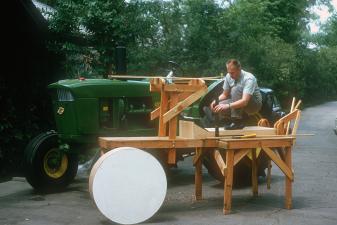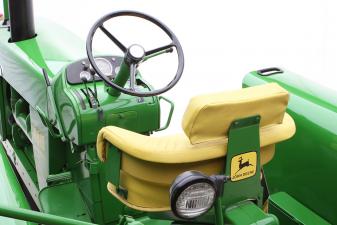John Deere Evolution: Revamping the Sound-Gard Body

John Deere Evolution is a visually stunning work that blends tractors photographed in custom-built studios with concept drawings and behind-the-scenes looks at how the machines were designed and built. This encyclopedic history covers every model line built by John Deere since 1919. In this excerpt from the book, read about the revamping of the Sound-Gard body.
William Crookes was ten years into a promising career when he began working for the prestigious Henry Dreyfuss Associates (HDA) as a young industrial designer, and he ended up spending his entire career working for the firm. One of his primary accounts was John Deere, and his first major project was a redesign of the Sound-Gard body created by a team consisting of William FH Purcell, Jim Conner, and Chuck Pelly.
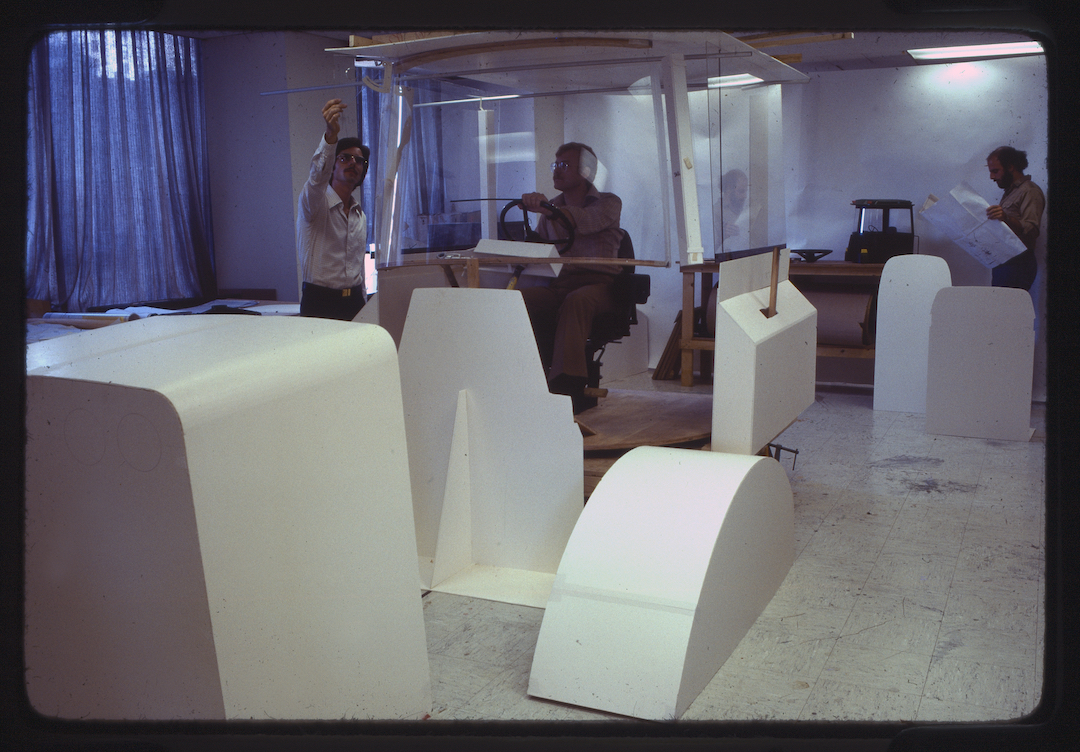 This wooden mockup was being used by HDA in August 1975. Photo courtesy of Henry Dreyfuss Archive, Cooper Hewitt, Smithsonian Design Museum.
This wooden mockup was being used by HDA in August 1975. Photo courtesy of Henry Dreyfuss Archive, Cooper Hewitt, Smithsonian Design Museum.
Crookes recalls that the initial design of the Sound-Gard was complex, particularly designing the entry door to work with the limited space available next to the roll-over protection system (ROPS).
Interestingly, he added that the soundproof cab actually created a host of unexpected problems to solve. “The seat suspension and seat that they were using on the open station tractors was a very noisy, sloppy system,” Crookes said. With the noise of the engine and other external sounds muted by the cab, the seat noise was nearly intolerable.
In the early days of ROPS, there were very few standards. As a result, the solution to the seat problem was less than ideal.
“So a very good friend of mine, Terry Woods, a gifted engineer, attached the seat suspension to the rear ROPS cross member. And when they hit the ROPS from the rear, the seat suspension went with it and they passed that ROPS test. The certifying body told the Deere engineers never, ever, ever, ever do that again. Because the whole idea of providing protection was to keep a zone that was free of any objects that might invade it,” Crookes said.
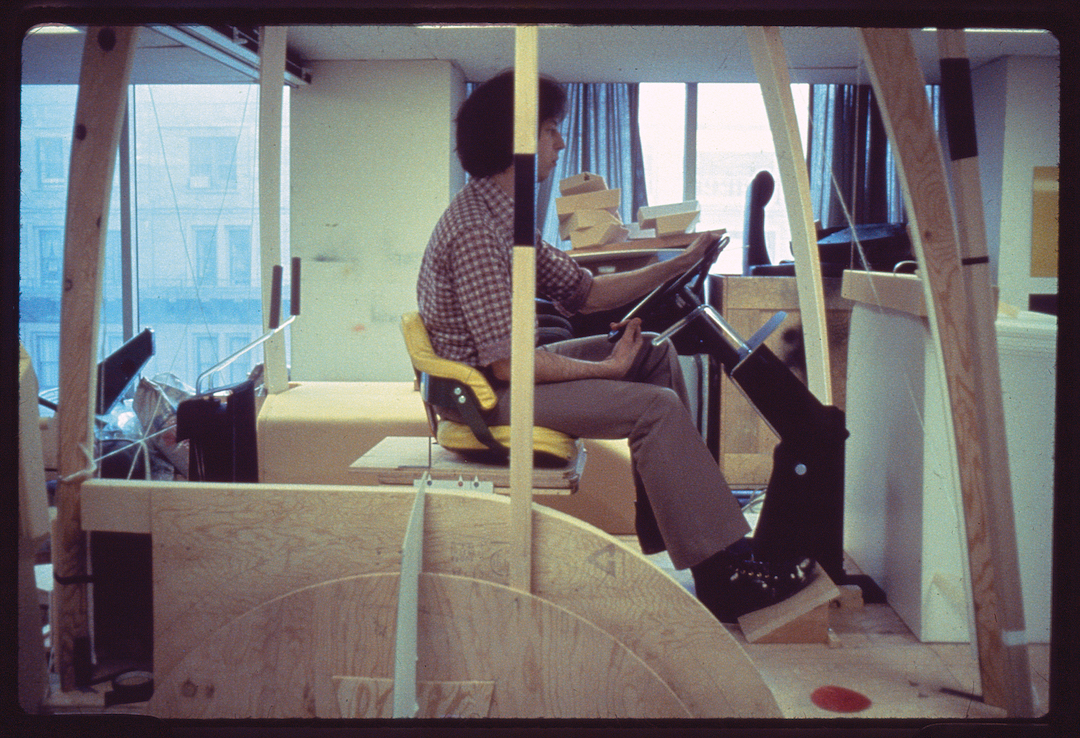 HDA logged countless hours developing the Deere controls and cab layout to accomodate a wide range of body types and sizes. Photo courtesy of Henry Dreyfuss Archive, Cooper Hewitt, Smithsonian Design Museum.
HDA logged countless hours developing the Deere controls and cab layout to accomodate a wide range of body types and sizes. Photo courtesy of Henry Dreyfuss Archive, Cooper Hewitt, Smithsonian Design Museum.
Crookes was assigned to fixing this situation and designing a new seat suspension system. This simple problem turned out to be a major engineering issue to truly fix. The issue was not simply with the seat suspension—it was also a matter of positioning.
The seat and cab had to be positioned roughly directly above the rear wheels for the operator to be able to lean back and see the drawbar and the hitch. This was mission critical positioning of course . . . and Crookes discovered it caused a significant problem. “The location of the cab was just above the rear axle center line and that gave a very difficult ride because the flotation in the tires are effectively a spring.”
Any bounce in the tires was transferred directly to the operator. To fix this, the cab would need to move forward, which was a massive engineering change and required creative solutions so the operator could see the hitch.
Another challenge Crookes faced was adapting the seat and controls to accommodate a wider range of body sizes.
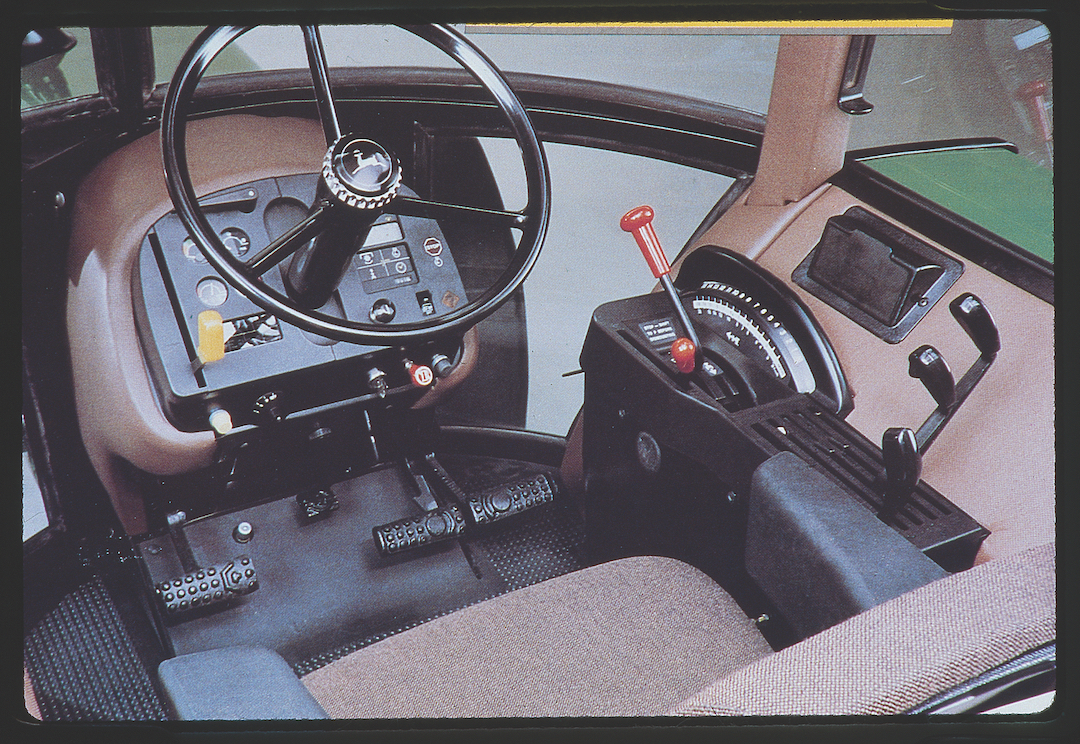 The end result of HDA's work with Deere was industry-leading comfort and user interface. Photo courtesy of Henry Dreyfuss Archive, Cooper Hewitt, Smithsonian Design Museum.
The end result of HDA's work with Deere was industry-leading comfort and user interface. Photo courtesy of Henry Dreyfuss Archive, Cooper Hewitt, Smithsonian Design Museum.
“We expanded the recommendations for sizes of operators not to be 90 percent of the population, but to be 95 percent of the population at that time,” Crookes said.
Henry Dreyfuss did a tremendous amount of work related to adapting the machine to fit men, a science known as Human Factors Engineering. HDA did work on this for the U.S. military, and developed extensive drawings and measurements showing the ranges of sizes designers and engineers needed to accommodate when creating new machines.
Grab your own copy of John Deere Evolution to keep reading more about the develpment of the Sound-Gard body.
William Crookes was ten years into a promising career when he began working for the prestigious Henry Dreyfuss Associates (HDA) as a young industrial designer, and he ended up spending his entire career working for the firm. One of his primary accounts was John Deere, and his first major project was a redesign of the Sound-Gard body created by a team consisting of William FH Purcell, Jim Conner, and Chuck Pelly.
 This wooden mockup was being used by HDA in August 1975. Photo courtesy of Henry Dreyfuss Archive, Cooper Hewitt, Smithsonian Design Museum.
This wooden mockup was being used by HDA in August 1975. Photo courtesy of Henry Dreyfuss Archive, Cooper Hewitt, Smithsonian Design Museum.Crookes recalls that the initial design of the Sound-Gard was complex, particularly designing the entry door to work with the limited space available next to the roll-over protection system (ROPS).
Interestingly, he added that the soundproof cab actually created a host of unexpected problems to solve. “The seat suspension and seat that they were using on the open station tractors was a very noisy, sloppy system,” Crookes said. With the noise of the engine and other external sounds muted by the cab, the seat noise was nearly intolerable.
In the early days of ROPS, there were very few standards. As a result, the solution to the seat problem was less than ideal.
“So a very good friend of mine, Terry Woods, a gifted engineer, attached the seat suspension to the rear ROPS cross member. And when they hit the ROPS from the rear, the seat suspension went with it and they passed that ROPS test. The certifying body told the Deere engineers never, ever, ever, ever do that again. Because the whole idea of providing protection was to keep a zone that was free of any objects that might invade it,” Crookes said.
 HDA logged countless hours developing the Deere controls and cab layout to accomodate a wide range of body types and sizes. Photo courtesy of Henry Dreyfuss Archive, Cooper Hewitt, Smithsonian Design Museum.
HDA logged countless hours developing the Deere controls and cab layout to accomodate a wide range of body types and sizes. Photo courtesy of Henry Dreyfuss Archive, Cooper Hewitt, Smithsonian Design Museum.Crookes was assigned to fixing this situation and designing a new seat suspension system. This simple problem turned out to be a major engineering issue to truly fix. The issue was not simply with the seat suspension—it was also a matter of positioning.
The seat and cab had to be positioned roughly directly above the rear wheels for the operator to be able to lean back and see the drawbar and the hitch. This was mission critical positioning of course . . . and Crookes discovered it caused a significant problem. “The location of the cab was just above the rear axle center line and that gave a very difficult ride because the flotation in the tires are effectively a spring.”
Any bounce in the tires was transferred directly to the operator. To fix this, the cab would need to move forward, which was a massive engineering change and required creative solutions so the operator could see the hitch.
Another challenge Crookes faced was adapting the seat and controls to accommodate a wider range of body sizes.
 The end result of HDA's work with Deere was industry-leading comfort and user interface. Photo courtesy of Henry Dreyfuss Archive, Cooper Hewitt, Smithsonian Design Museum.
The end result of HDA's work with Deere was industry-leading comfort and user interface. Photo courtesy of Henry Dreyfuss Archive, Cooper Hewitt, Smithsonian Design Museum.“We expanded the recommendations for sizes of operators not to be 90 percent of the population, but to be 95 percent of the population at that time,” Crookes said.
Henry Dreyfuss did a tremendous amount of work related to adapting the machine to fit men, a science known as Human Factors Engineering. HDA did work on this for the U.S. military, and developed extensive drawings and measurements showing the ranges of sizes designers and engineers needed to accommodate when creating new machines.
Grab your own copy of John Deere Evolution to keep reading more about the develpment of the Sound-Gard body.


